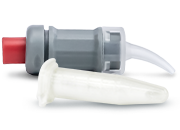
Topics Discussed and Key Points:
- Advantages and disadvantages of using different materials for space maintainer impressions
- The use of digital impressions for pediatric dentistry
- Common mistakes dentists and dental assistants make with impressions
- Tips and tricks to get the correctly sized orthodontic bands
- How to ensure maximum accuracy when working with a dental laboratory
Kevin Ohlendorf
Kevin Ohlendorf serves as President of Ohlendorf Appliance Laboratory in St. Louis, Missouri, which has been family-owned since 1933. He speaks with us on best practices around dental appliances.
Alginate Impressions
Regarding advantages and disadvantages of different materials, Kevin first notes that he usually receives space maintainers that use alginate impressions, which Kevin considers the most reliable material. He rarely receives compound material, which he dissuades doctors from using anyway as it is known for producing inaccuracies.
One of the challenges with alginate, however, is its stability over time. Kevin highly suggests using Kromopan, which holds exceptionally well for 100 hours before the impression begins to distort. It is also best to pour the model in your own office so that you can double-check the cast for distortions before sending it out. Kromopan changes color as soon as it sets so it takes the guess work out of set time. He warns against using the triple trays and suggests using plastic or metal trays.
Digital Impressions
On the topic of digital impressions, Kevin expresses his surprise at how successful it was at innovating the industry. While originally a “hit-or-miss” a few years back, now more and more doctors are switching to purely digital. Obviously, digital impressions are more accurate. They are particularly useful when taking impressions from fidgety children, as the system will let you know if a rescan is needed for a specific spot.
Evaluating Impressions before Sending Off
When evaluating what to watch out for when sending in impressions, Kevin notes distortion as the first and most common reason for calling a doctor back. Another is partially-erupted molars, as it is difficult to fit bands around them. Kevin suggests that doctors make their own bands for this reason, as more accuracy can be expected. For the sake of efficiency and even further accuracy, it helps to take the impression without the band on, then send them in separately loose in a plastic bag.
Crown and Loop
If a doctor wanted to do a crown and loop, they would take an impression, size a crown, prep and cement or prep the crown, take an impression, then leave the tooth unprepped while waiting for the space maintainer.
Space Maintainers
For space maintainers, Kevin encourages doctors to let him know where they want to band the teeth, and for what teeth they need the space retained for. The more information the lab has on the prescription sheet, the better. This will allow them to fabricate exactly what a doctor is expecting.
If a doctor is not sure how something should be designed, or if they are not even sure exactly what appliance is needed, it helps to request the lab to give them a call about the case. That way, the doctor can consult with them on every available option. Kevin’s dedication to personalizing every case means that he is willing to reach out to his clients to take into account every necessary detail in order to accomplish each individual case brought to him.
Turn Around
Kevin notes standard turn around for a dental appliance from Ohlendorf Appliance Laboratory is two weeks from the time it leaves your office to fabrication, and back to you. They recently overhauled their entire workflow to reduce turn around to 10-12 days. Visit their website https://ohlendorfappliancelab.com/ or their YouTube channel for more information.


